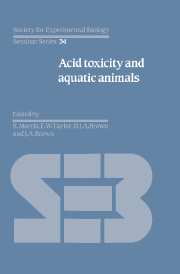Book contents
- Frontmatter
- Contents
- Contributors
- Units, Symbols and Formulae
- Preface
- Introduction: The causes and consequences of surface water acidification
- Invertebrate communities in acid streams
- Fish survival in acid waters
- Field studies on fisheries in acid waters in the UK
- Episodic changes in water quality and their effects on fish
- Acid–base regulation in fishes: 1. Mechanisms
- Acid–base regulation in fishes: 2. Biological responses and limitations
- Intracellular pH regulation and the effects of external acidification
- The physiological problems of fish in acid waters
- Laboratory studies on invertebrate survival and physiology in acid waters
- The physiological problems of crayfish in acid waters
- The effects of hydrogen and aluminium ions on fish gills
- The combined effects of pH and trace metals on fish ionoregulation
- Endocrine responses to acid stress in fish
- Commentary and conclusions
- Index
The combined effects of pH and trace metals on fish ionoregulation
Published online by Cambridge University Press: 05 February 2012
- Frontmatter
- Contents
- Contributors
- Units, Symbols and Formulae
- Preface
- Introduction: The causes and consequences of surface water acidification
- Invertebrate communities in acid streams
- Fish survival in acid waters
- Field studies on fisheries in acid waters in the UK
- Episodic changes in water quality and their effects on fish
- Acid–base regulation in fishes: 1. Mechanisms
- Acid–base regulation in fishes: 2. Biological responses and limitations
- Intracellular pH regulation and the effects of external acidification
- The physiological problems of fish in acid waters
- Laboratory studies on invertebrate survival and physiology in acid waters
- The physiological problems of crayfish in acid waters
- The effects of hydrogen and aluminium ions on fish gills
- The combined effects of pH and trace metals on fish ionoregulation
- Endocrine responses to acid stress in fish
- Commentary and conclusions
- Index
Summary
Introduction
In freshwater fish the physiological regulation of the major electrolytes is very sensitive to environmental stressors. Low pH environments in both the laboratory and field cause electrolyte losses in a number of fish species and, indeed, plasma electrolytes have proven to be a fairly reliable indicator of sublethal acid stress (e.g. Leivestad & Muniz, 1976). Similarly, there are now several studies on the toxic trace metals showing that disturbances to ion regulation are either a primary or at least a secondary consequence of exposure to a particular metal. Our objective then is to examine how mixtures of trace metals and H+ might toxically interact to cause ionic disturbances. We have placed emphasis on sublethal effects upon gill function rather than toxicity per se. We first examine the chemical and biological bases for metal and H+ interactions and then present some examples which illustrate the nature of these interactions. It is not our intention to review exhaustively metal and H+ toxicity but rather to point out how one might examine or even predict the interactions of untested metal/H+ mixtures. For a more general and thorough treatment of metal and acid toxicity to aquatic biota the reader is referred to the recent review by Campbell & Stokes (1985).
In terrestrial animals, the toxicity of a particular metal is mainly related to its dose; if a metal is not absorbed then it is not toxic, irrespective of its reactivity in aqueous solution.
- Type
- Chapter
- Information
- Acid Toxicity and Aquatic Animals , pp. 221 - 242Publisher: Cambridge University PressPrint publication year: 1989
- 44
- Cited by

